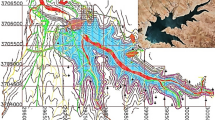Abstract
A simulation–optimization framework is presented for allocating releases from Bukan Dam, the largest infrastructure in Urmia Lake Basin, to downstream uses in Zarrineh river basin in Iran. The framework links the water evaluation and planning system (WEAP) simulation module and particle swarm optimization (PSO) algorithm. WEAP by itself optimizes spatial water allocations to demand nodes in a single time period terminal subject to known demand priorities and supply preferences. However, PSO linked to WEAP determines optimal reservoir releases and downstream water allocations over a multi-period planning horizon. The PSO objective function is minimizing the sum of squared water shortages over the planning horizon considering the end-of-year reservoir storage conditions. Results of the model application in year 2012–2013 reveal different demands are met satisfactorily, whereas historical operations have led to shortages in meeting Lake Urmia’s environmental water requirement.
Access this chapter
Tax calculation will be finalised at checkout
Purchases are for personal use only
Similar content being viewed by others
References
Gavahi K, Mousavi J (2017) Real time operation model for optimum operation of Bukan Reservoir in Lake Urmia Basin. Long-term behaviour and environmentally friendly rehabilitation technologies of dams (LTBD 2017). https://doi.org/10.3217/978-3-85125-564-5-076
Gavahi K, Mousavi SJ, Ponnambalam K (2018) Comparison of two data-driven streamflow forecast approaches in an adaptive optimal reservoir operation model, vol 3, pp 755–745. https://doi.org/10.29007/wrn8
Gavahi K, Mousavi SJ, Ponnambalam K (2019) The role of sreamflow forecast horizon in real-time reservoir operation. Sustainable and safe dams around the world, pp 1603–1610.https://doi.org/10.1201/9780429319778-143
Emami F, Koch M (2018) Agro-economic water productivity-based hydro-economic modeling for optimal irrigation and crop pattern planning in the Zarrine river basin, Iran, in the wake of climate change. Sustainability 10(11):3953. https://doi.org/10.3390/su10113953
Alizadeh H, Mousavi SJ (2013) Coupled stochastic soil moisture simulation-optimization model of deficit irrigation. Water Resour Res 49(7):4100–4113. https://doi.org/10.1002/wrcr.202822013
Chakraei I, Safavi HR, Dandy GC, Golmohammadi MH (2021) Integrated simulation-optimization framework for water allocation based on sustainability of surface water and groundwater resources. J Water Resour Plan Manag 147(3):05021001. https://doi.org/10.1061/(ASCE)WR.1943-5452.0001339
Dehghanipour AH, Schoups G, Zahabiyoun B, Babazadeh H (2020) Meeting agricultural and environmental water demand in endorheic irrigated river basins: a simulation-optimization approach applied to the Urmia Lake basin in Iran. Agric Water Manag 241:106353. https://doi.org/10.1016/j.agwat.2020.106353
Mousavi SJ, Anzab NR, Asl-Rousta B, Kim JH (2017) Multi-objective optimization-simulation for reliability-based inter-basin water allocation. Water Resour Manage 31:3445–3464. https://doi.org/10.1007/s11269-017-1678-6
SEI (1999) WEAP: water evaluation and planning. Tellus Institute, Boston
Gendreau M, Potvin JY (2010) Handbook of metaheuristics, vol 2. Springer, New York
Maier HR et al (2014) Evolutionary algorithms and other metaheuristics in water resources: current status, research challenges and future directions. Environ Model Softw 62:271–299. https://doi.org/10.1016/j.envsoft.2014.09.013
East Azerbaijan Department of Environment (2016) Determining environmental water requirements of wetlands and rivers in Urmia Basin
MG Consulting Engineers (2013) Water master plan of Urmia Lake Basin. Preliminary water resources planning study. Tehran, Iran
Author information
Authors and Affiliations
Corresponding author
Editor information
Editors and Affiliations
Rights and permissions
Copyright information
© 2022 The Author(s), under exclusive license to Springer Nature Singapore Pte Ltd.
About this paper
Cite this paper
Asadi, S., Mousavi, S.J. (2022). Optimal Water Allocation in Zarrineh River Basin: PSO-WEAP Model. In: Kim, J.H., Deep, K., Geem, Z.W., Sadollah, A., Yadav, A. (eds) Proceedings of 7th International Conference on Harmony Search, Soft Computing and Applications. Lecture Notes on Data Engineering and Communications Technologies, vol 140. Springer, Singapore. https://doi.org/10.1007/978-981-19-2948-9_48
Download citation
DOI: https://doi.org/10.1007/978-981-19-2948-9_48
Published:
Publisher Name: Springer, Singapore
Print ISBN: 978-981-19-2947-2
Online ISBN: 978-981-19-2948-9
eBook Packages: Intelligent Technologies and RoboticsIntelligent Technologies and Robotics (R0)




